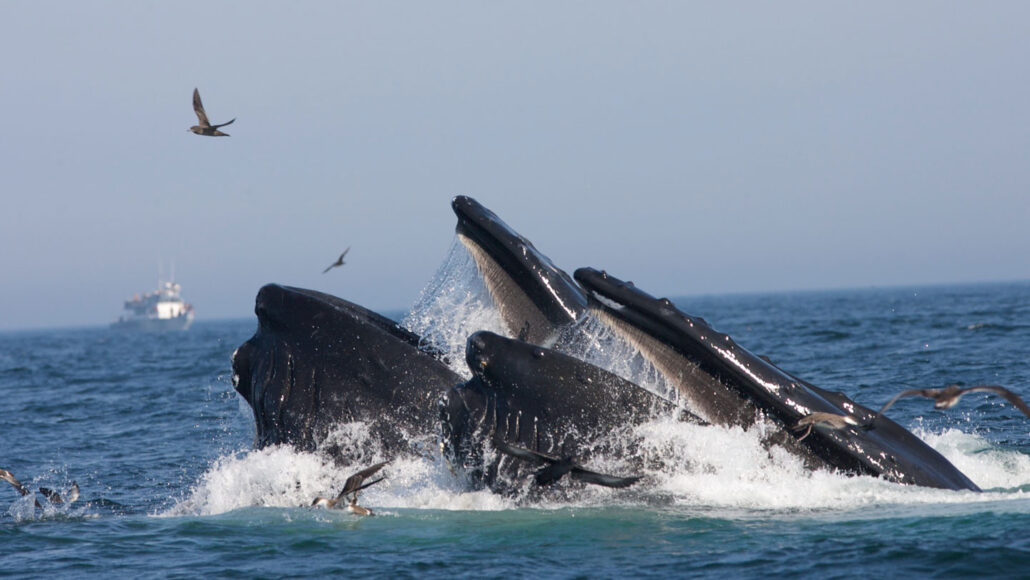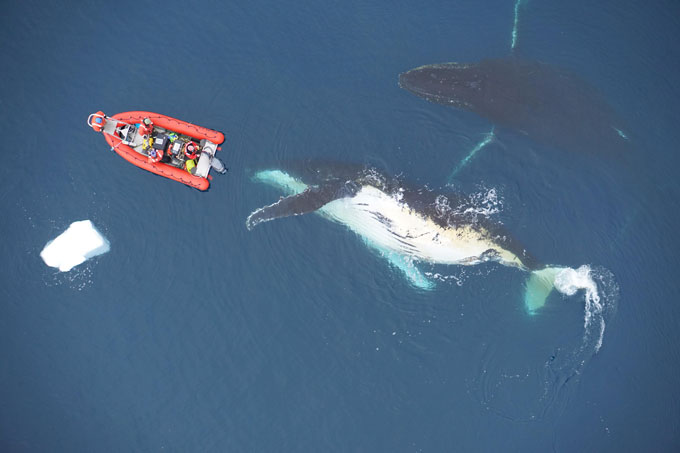Baleen whales eat — and poop — a lot more than we thought
In just one day, a blue whale can gulp down the number of calories found in 30,000 Big Macs

Humpback whales feed on fish off the coast of Massachusetts. New research suggests that baleen whales, including these humpbacks, eat a lot more than scientists had realized.
Elliott Hazen
Whale hunting has plundered the seas of giant whales for much of the last century. With the help of modern technology, people have killed up to 99 percent of certain species. Some scientists thought this would cause krill — the tiny crustaceans that many whales gulp down — to explode in number. But that didn’t happen. New research suggests whale poop, or a lack of it, may explain this.
Krill numbers in Antarctic waters with lots of whale hunting have dropped by more than 80 percent. With fewer of these crustaceans, many other krill predators have gone hungry, such as seabirds and fish.
A new study looked at the eating habits of baleen whales (those that use long keratin plates of baleen to help snag prey). These include blue and humpback whales. Apparently, baleen whales eat about three times as much food as we thought. Lots more food means lots more poop. That poop is rich in iron. So with fewer whales, ecosystems get less iron and other crucial nutrients that they need to thrive. That hurts other species, including krill.
The team shared its findings in the November 4 Nature. Restoring whale populations, the researchers say, could help these ecosystems recover.
“It’s hard to know what role whales play in ecosystems without knowing how much they’re eating,” says Joe Roman. This marine ecologist wasn’t involved in the new study. He works at the University of Vermont in Burlington. How much whales eat had not been well known, he says. This study will “allow us to better understand how the widespread depletion of whales has impacted ocean ecosystems.”
Whale of a problem
Gauging whale diets is not easy. Some of these animals are around the size of Boeing 737 jets. They gulp down hordes of centimeter-long invertebrates that live far below the surface of the ocean. In the past, scientists have relied on assessing what these behemoths eat by dissecting the stomachs of dead whales. Or researchers estimated how much energy whales should need based on their size.
“These studies were educated guesses,” says Matthew Savoca. But, he adds, “none were conducted on live whales in the wild.” Savoca is a marine biologist at Hopkins Marine Station. Part of Stanford University, it’s in Pacific Grove, Calif.
New technology allowed Savoca and his colleagues to get a more precise estimate of what whales eat. He notes that this was “a chance to answer a really basic biological question about some of the most charismatic animals on Earth.”
His team needed to know three things. First, how often do whales feed? Second, how big is each of their gulps of prey? And third, how much food is in each of those gulps? To gather these data, the team suction-cupped sensors to the backs of 321 whales. They came from seven different species. The sensors tracked when the whales lunged for prey. Drones also snapped photos of 105 whales to help the researchers estimate gulp size. Finally, sonar mapping revealed the density of krill in the whales’ feeding areas.

Combining these data provided a more detailed look at feeding than ever before, says Sarah Fortune. Savoca and his colleagues “measured all the things you need to measure to get an accurate estimate of consumption.” Fortune is a marine ecologist who did not take part in the new study. She works at Fisheries and Oceans Canada in Vancouver, British Columbia.
On average, baleen whales eat about three times as much food as earlier estimates had suggested. For example, a blue whale can gulp down 16 metric tons of krill — about 10 million to 20 million calories — in a day. That’s like one of these supersized creatures wolfing down 30,000 Big Macs, Savoca says.
Whales don’t eat that much every day. At times when the animals are migrating vast distances, they may go months without taking a bite. But the sheer volume of food that they eat and then poop out suggests that whales play a far bigger role in shaping ocean ecosystems than we thought, Savoca says. That makes the loss of whales that much more harmful.
Why whales are a big deal
Whales are nutrient cyclers. They feed on iron-rich krill in the deep sea. Later, they return some of that iron to the surface in the form of poop. This helps keep iron and other crucial nutrients in the food web. Hunting whales might have broken this iron cycle. Fewer whales bring less iron to the ocean’s surface. With less iron there, phytoplankton blooms shrink. Krill and many other creatures that feast on phytoplankton may now suffer. Such changes will make the ecosystem suffer, Savoca says.
The industrial hunting of whales killed millions of the huge animals in the 20th century. Researchers now estimate that before then, baleen whales in the Southern Ocean alone consumed 430 million metric tons of krill each year. Today, less than half that amount of krill lives in those waters. Smaller whale populations are likely the reason for this, Savoca says. “When you wholesale remove them, the system becomes, on average, less [healthy].”
Some whale populations are rebounding. If whales and krill returned to their early 1900s numbers, the productivity of the Southern Ocean could be boosted by 11 percent, the researchers calculate. That increased productivity would translate into more carbon-rich life, from krill to blue whales. Together, those creatures would store 215 million metric tons of carbon each year. The carbon stored in those creatures wouldn’t be able to escape into the atmosphere and contribute to global warming. It would be like taking more than 170 million cars off the road each year.
“Whales are not the solution to climate change,” Savoca says. “But rebuilding whale populations would help a sliver, and we need lots of slivers put together to solve the problem.”







